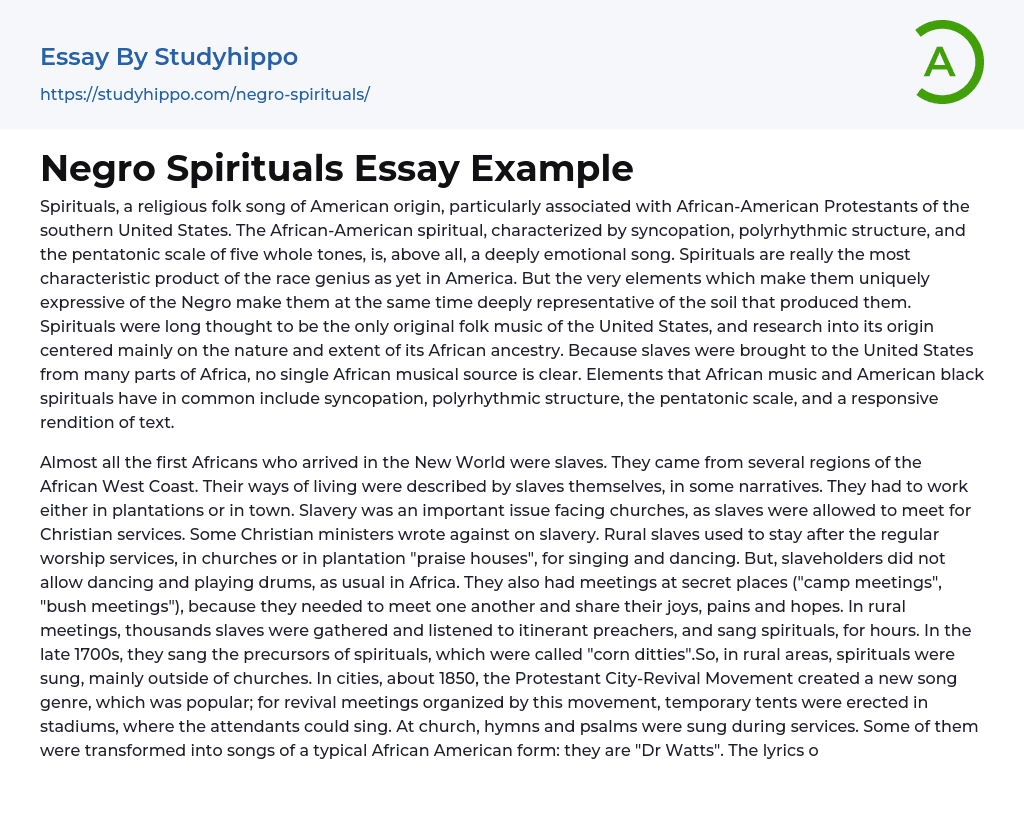Spirituals, a religious folk song of American origin, particularly associated with African-American Protestants of the southern United States. The African-American spiritual, characterized by syncopation, polyrhythmic structure, and the pentatonic scale of five whole tones, is, above all, a deeply emotional song. Spirituals are really the most characteristic product of the race genius as yet in America. But the very elements which make them uniquely expressive of the Negro make them at the same time deeply representative of the soil that produced them. Spirituals were long thought to be the only original folk music of the United States, and research into its origin centered mainly on the nature and extent of its African ancestry. Because slaves were brought to the United States from many parts of Africa, no single African musical source is clear. Elements that African musi
...c and American black spirituals have in common include syncopation, polyrhythmic structure, the pentatonic scale, and a responsive rendition of text.
Almost all the first Africans who arrived in the New World were slaves. They came from several regions of the African West Coast. Their ways of living were described by slaves themselves, in some narratives. They had to work either in plantations or in town. Slavery was an important issue facing churches, as slaves were allowed to meet for Christian services. Some Christian ministers wrote against on slavery. Rural slaves used to stay after the regular worship services, in churches or in plantation "praise houses", for singing and dancing. But, slaveholders did not allow dancing and playing drums, as usual in Africa. They also had meetings at secret places ("camp meetings", "bush meetings"), because they needed to meet one
another and share their joys, pains and hopes. In rural meetings, thousands slaves were gathered and listened to itinerant preachers, and sang spirituals, for hours. In the late 1700s, they sang the precursors of spirituals, which were called "corn ditties".So, in rural areas, spirituals were sung, mainly outside of churches. In cities, about 1850, the Protestant City-Revival Movement created a new song genre, which was popular; for revival meetings organized by this movement, temporary tents were erected in stadiums, where the attendants could sing. At church, hymns and psalms were sung during services. Some of them were transformed into songs of a typical African American form: they are "Dr Watts". The lyrics of negro spirituals were tightly linked with the lives of their authors: slaves. While work songs dealt only with their daily life, spirituals were inspired by the message of Jesus Christ and his Good News (Gospel) of the Bible, "You can be saved". They are different from hymns and psalms, because they were a way of sharing the hard condition of being a slave. Many slaves in town and in plantations tried to run to a "free country", that they called "my home" or "Sweet Canaan, the Promised Land". This country was on the Northern side of Ohio River, that they called "Jordan". Some negro spirituals refer to the Underground Railroad, an organization for helping slaves to run away.
The Spirituals are spiritual. Conscious artistry and popular conception alike should never rob them of this heritage, untrue to their tradition and to the folk genius to give them another tone. That they are vulnerable of both crude and refined secularization is no excuse. Even
though their own makers worked them up from the "shout" and the rhythmic elements of the sensuous dance, in their finished form and basic emotional effect all of these elements were completely sublimated in the sincere intensities of religious seriousness. To call them Spirituals and treat them otherwise is a travesty. Emotionally, African slave songs were far from simple. They are not only spread over the whole length of human moods, with the traditional religious overtone skillfully insinuated in each instance, but there is further a sudden change of mood in the single song, baffling to formal classification. Emotional themes relate these songs to the folk activities that they motivated, classifying them by their respective song-types. From this point of view we have essentially four classes, the almost ritualistic prayer songs or pure Spirituals, the freer and more unrestrained evangelical "shouts" or camp-meeting songs, the folk ballads so overlaid.
- Baptism essays
- Holy Spirit essays
- Jesus Christ essays
- Adam And Eve essays
- Crucifixion Of Jesus essays
- Crusades essays
- Eucharist essays
- God The Father essays
- Pope essays
- Protestantism essays
- Christian essays
- Church essays
- Elizabeth essays
- Sacrament essays
- Catholic Church essays
- Lord essays
- Priest essays
- Protestant Reformation essays
- Sonnet essays
- Concert essays
- Piano essays
- Hip Hop essays
- Music Reference essays
- Musical Instruments essays
- Mp3 essays
- Recording essays
- Music video essays
- Singing essays
- Song essays
- Tupac shakur essays
- Classical Music essays
- Opera essays
- Rock Music essays
- Blues essays
- Jazz essays
- Sonata essays
- Baroque Music essays
- Rock And Roll essays
- Ludwig Van Beethoven essays
- Michael Jackson essays
- Popular music essays
- Band essays
- Classical Concert essays
- Music Concert Report essays
- Music Awards essays
- Walk This Way essays
- Song Analysis essays
- Afterlife essays
- Atheism essays
- Bible essays




